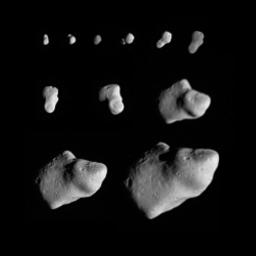
|
Gaspra Approach Sequence
- Click the image above for a larger view
- Full-Res JPEG (1000 x 1000) (32.1 kB)
- Full-Res TIFF (1000 x 1000) (234.4 kB)
Caption:
This montage of 11 images taken by the Galileo spacecraft as it flew by the asteroid Gaspra on October 29, 1991, shows Gaspra growing progressively larger in the field of view of Galileo's solid-state imaging camera as the spacecraft approached the asteroid. Sunlight is coming from the right. Gaspra is roughly 17 kilometers (10 miles) long, 10 kilometers (6 miles) wide. The earliest view (upper left) was taken 5 3/4 hours before closest approach when the spacecraft was 164,000 kilometers (102,000 miles) from Gaspra, the last (lower right) at a range of 16,000 kilometers (10,000 miles), 30 minutes before closest approach. Gaspra spins once in roughly 7 hours, so these images capture almost one full rotation of the asteroid. Gaspra spins counterclockwise; its north pole is to the upper left, and the "nose" which points upward in the first image, is seen rotating back into shadow, emerging at lower left, and rotating to upper right. Several craters are visible on the newly seen sides of Gaspra, but none approaches the scale of the asteroid's radius. Evidently, Gaspra lacks the large craters common on the surfaces of many planetary satellites, consistent with Gaspra's comparatively recent origin from the collisional breakup of a larger body.
Background Info:
The Galileo project, whose primary mission is the exploration of the Jupiter system in 1995-97, is managed for NASA's Office of Space Science and Applications by the Jet Propulsion Laboratory.
Cataloging Keywords:
| Name | Value | Additional Values |
|---|---|---|
| Target | 951 Gaspra | |
| System | Main Belt | |
| Target Type | Asteroid | |
| Mission | Galileo | |
| Instrument Host | Galileo Orbiter | |
| Host Type | Orbiter | |
| Instrument | Solid-State Imaging (SSI) | |
| Detector | ||
| Extra Keywords | Collision, Crater, Grayscale, Rotation, Shadow | |
| Acquisition Date | ||
| Release Date | 1996-01-29 | |
| Date in Caption | 1991-10-29 | |
| Image Credit | NASA/JPL | |
| Source | photojournal.jpl.nasa.gov/catalog/PIA00079 | |
| Identifier | PIA00079 | |
